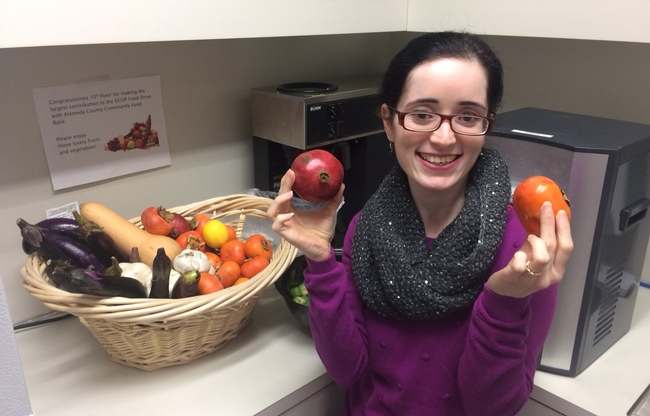To celebrate National Food Day, University of California Office of the President employees in Oakland donated a total of $3,808 and 283 cans and packages of food to the Alameda County Community Food Bank. The food drive was sponsored by UC Agriculture and Natural Resources and UCOP Staff Assembly.
The cash donations translated into nearly $23,000 worth of fresh fruits, vegetables and other healthy food items for the 49,000 local families the food bank serves each week, said Suzanna Martinez, Nutrition Policy Institute analyst, who organized the food drive.
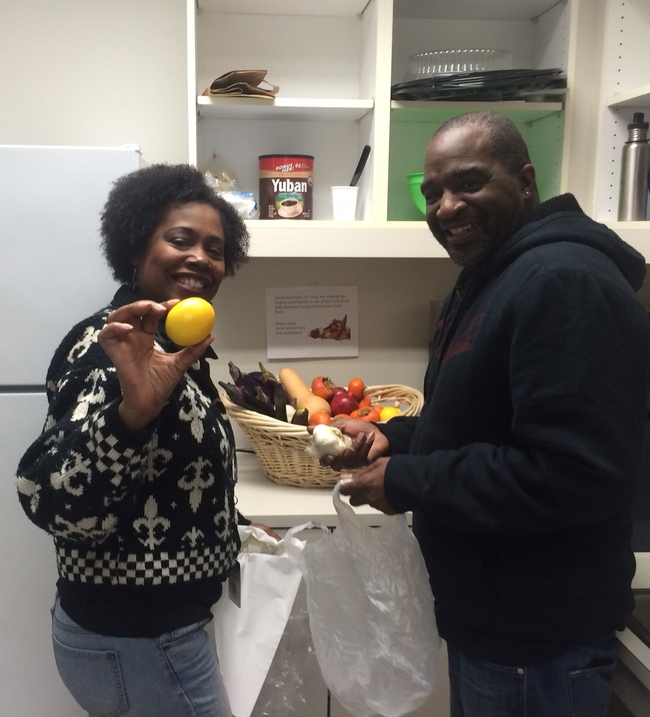
At the end of the week, Martinez tallied the donations and awarded points – one point per food item and one point per dollar donated online. The floor with the most points at the end of the week won the fresh produce.
The winners of the $100 farmers market basket were the employees of the 10th floor of the Franklin Street building, who donated $888. Coincidentally UC ANR's headquarters is on the 10th floor. Runners-up in the competition were the 20th Street building, which raised $673, and Franklin 5th floor, which donated $570.
- Author: Jeannette E. Warnert

The story centers on 10-year-old Jack's return to the Black Rock Range for a summer of swimming, gold hunting and hanging out with the wildlife friends he made in the first book: Sonny the coyote and Pinta the pallid bat. But peace is soon shattered by the howls of ferocious wolves, a sudden illness in the family, and the plight of Jack's uncle, who is knocked unconscious by two ruthless cattle rustlers.
Jack and his animal pals have no choice but to embark on a perilous trek to rescue Uncle Ray from armed and dangerous criminals, and make sure justice is served.
Jack exhibits maturity and good judgement – packing a loaf of bread and jar of peanut butter to keep him and the animals sustained through the ordeal. He is crafty, finding a safe haven on top of a large bolder when threatened by the pack of wolves. He is resolute, hiking for hours in rough conditions, tracking clues, and carefully tending to the injuries of a raven harmed by the rustlers. Children will be so captivated with the adventure, they will not realize they are learning.
The book is subtly laced with natural history and animal biology. Sonny the coyote is “like a large dog, but lean and strong with tan-colored fur, long skinny legs and a big busy tail.” He helps Jack track the bad guys with his sense of smell and eats ripe berries off bushes with his teeth, “his lips curled back to avoid the thorns.”

The environment is an important part of the narrative.
“The streambed they followed was wide and sandy at first, but slowly began to narrow and became more gravely as they steadily made their way up the mountain,” Long wrote. “The landscape also changed when they increased in elevation and the temperature cooled, with buck brush, bunch grasses, and oak trees replacing the dominant sagebrush found in the desert below.”
The first book in the Black Rock Desert trilogy, Gold Fever, was published in 2012, but the stories go back much farther. During long commutes, Long would tell her toddler son about Jack's adventures. Her son is now 18. Long's personal affinity for bats made Pinta an indispensable part of the story.
As a UC ANR farm advisor, Long researches bats' contribution to agriculture. She recently studied the economic value contributed by bats in terms of pest control in walnut orchards. For a typical 80-acre orchard producing 136 tons of walnuts per year, she estimated that bats protect about 6 percent of the crop yield, or $29,700 worth of walnuts per season at the current price of $1.65 per pound.
Long also authored the UC publication Songbird, Bat and Owl Boxes, which outlines methods for integrating nest boxes with farm management, provides details on construction and maintenance of nesting boxes, and provides information on other sources of reliable bat information. The publication includes plans for building a wildlife nesting house.
Her children's books, Valley of Fire and Gold Fever, are available for $11.99 each from Tate Publishing. The books can also be published on Amazon.com. The final book in the series will be published in 2016.
An initiative to maintain and enhance healthy families and communities is part of the UC Division of Agriculture and Natural Resources Strategic Vision 2025.
- Author: Norma De la Vega
- Translated from Spanish by: Jeannette E. Warnert

Patti Wooten Swanson, a UC Agriculture and Natural Resources consumer sciences expert, shares four recommendations that can help consumers make the best use of their tax refunds.
1.
Think before spending. While waiting for your refund check to arrive, make plans. Talk to members of the family about your financial priorities:
- Are you behind on mortgage or student loan payments?
- Do you owe money on your credit cards?
- Does the family need a new refrigerator?
- Have you postponed important dental treatment because you don't have enough money?
Plan how to spend the refund rather than simply heading to the shopping mall or electronics store when the check arrives.
2.
Use part or all of the refund to start establishing long-term financial security.
Lists of ways to use your tax refund typically include “save for retirement” among the options. You cannot go wrong if you save for retirement, but here are a few other ways that you can achieve financial security.
- Save for your children's college educations
- Deposit the check in a rainy-day fund
- Pay off credit cards that have high interest rates
- Pay for professional development classes that will help you earn a higher salary or increase your employment outlook – such as learning another language, finishing college, taking a class to learn new skills, such as management or new computer skills needed in your field.
3.
Do not use your refund to add to your debt.
Maybe you would like to buy something expensive that you have always wanted. But, if you use the refund to make a down payment on a large purchase – such as a flat-screen television, new bedroom furniture or a car – you have further indebted yourself and will have to make higher monthly payments going forward. Before making this purchase, consider whether your budget allows for another monthly payment.
4.
Do not throw away money by signing onto a scheme that provides the refund immediately.
Refund anticipation loans (RAL) charge you a fee for lending you money until the government sends the check. Why would you pay for this? Instead, file your taxes electronically and you will receive the refund in about 10 days. Enjoy the money that you have earned!
- Author: Pamela Kan-Rice
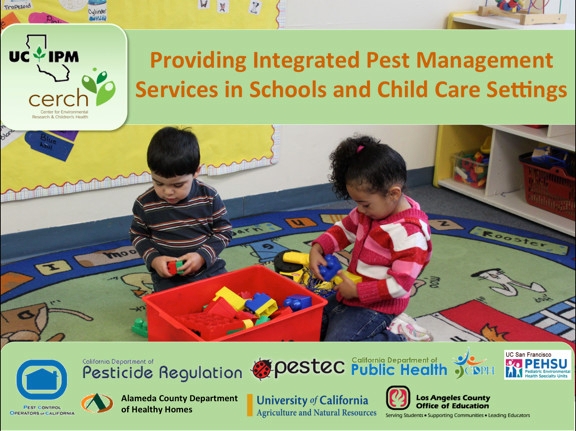
Pest management professionals can learn about the requirements of California's Healthy Schools Act by taking a free online course provided by the UC Statewide Integrated Pest Management Program (UC IPM), part of University of California Agriculture and Natural Resources (UC ANR).
To minimize children's exposure to pesticides, California requires pest control operators providing services in schools and licensed child care centers to comply with a series of laws called the Healthy Schools Act. The laws promote integrated pest management (IPM) in public K–12 schools and licensed private child care centers.
The free course Providing Integrated Pest Management Services in Schools and Child Care Settings explains what the Healthy Schools Act requires of schools, child care centers and pest control companies when managing pests in these environments.
"Taking the online course makes it easier to understand and comply with the laws," said Andrew Sutherland, UC ANR Cooperative Extension IPM advisor. "Pest management professionals can take the course at their convenience. It tells them everything they need to know about the Healthy Schools Act and IPM in order to do business with a school or child care center."
The course also includes a section on how companies can prosper by incorporating IPM principles and practices into their businesses.
"This is an opportunity for operators to take their businesses to the next level by adopting IPM practices," Sutherland said. "IPM effectively and efficiently manages pests, builds professionalism within providers, and captures value for the customer while minimizing pesticide applications, pesticide exposures and associated negative impacts on children's health, the environment and the larger community."
Licensed pest-management professionals can receive continuing education units by completing the online course: one "Rules and Regulations" and one "IPM" from the Structural Pest Control Board; and one "Laws and Regulations" and one "Other" from the Department of Pesticide Regulation.
UC Berkeley's Center for Environmental Research and Children's Health is developing a database of individuals who complete the course so that schools and child care centers can connect with pest control providers who are familiar with IPM and the Healthy Schools Act.
The training module was developed by Sutherland and collaborators at UC Berkeley and UC San Francisco, with input from California pest management professionals and child care providers.
To take the free Providing Integrated Pest Management Services in Schools and Child Care Settings course, see the UC IPM website http://ucanr.edu/ipm4schools.
This project was funded by the California Department of Pesticide Regulation Pest Management Alliance Program. For more information about the Healthy Schools Act, visit the California Department of Pesticide Regulation's School IPM web page http://apps.cdpr.ca.gov/schoolipm.
An initiative to maintain and enhance healthy families and communities is part of the UC Agriculture and Natural Resources Strategic Vision 2025.
- Author: Pamela Kan-Rice

It's not easy for immigrant farmers to market their produce. They often lack the contacts or even language skills to forge business relationships with large produce distributors. Meanwhile, consumers are clamoring for fresh, locally grown fruits and vegetables and produce buyers are working to meet that demand by purchasing more from small-scale and local growers.
Small-scale farmers, mostly Hmong immigrants, from the Fresno area toured the Bay Area on Feb. 18 to meet wholesale produce buyers and distributors to learn how the operations work and what they need from growers. The tour was organized by the UC Agriculture and Natural Resources (UC ANR) and its Sustainable Agricultural Research and Education Program (SAREP).
“The Hmong farmers returned to Fresno with buyers who want to purchase their products,” said Thomas Nelson, UC ANR SAREP's sustainable supply chain analyst, who led the tour. “The day gave them a sense of the opportunities, market demand and next steps for growing their businesses.”

John Wong, president of Pacific Rim Produce, buys from local farmers to offer more than 200 produce items to supermarkets, restaurants, food processors, food service delivery companies, hotels, and casinos.
Four things are essential to being a successful farmer, “Growing, marketing, commitment and branding,” said Wong, who takes pride in coaching small-scale growers to build successful businesses.
Growing quality produce, packing and storing it under the best conditions to preserve the quality are important, he said, with Michael Yang, UC ANR Cooperative Extension Hmong agricultural assistant in Fresno County, translating the conversation for the growers.
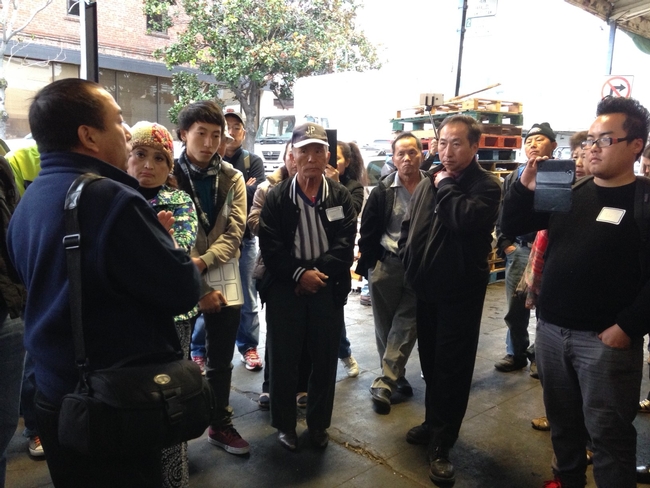
Wong encouraged the growers to build a brand for their businesses so that consumers will recognize their products in markets. He also cautioned against hurting their reputation by breaking a commitment to sell to a buyer if another buyer offers a higher price.
On Feb. 24, UC ANR SAREP will host Bay Area farmers for a similar tour to meet with produce buyers.
“The February 24 tour will introduce beginning farmers to traditional and innovative values-based channels for selling their products,” said Nelson.” In addition to buyers, the farmers will meet other key actors who are working to build sustainable and local food supply chains, including food safety experts, microfinance lenders, food hubs operators.”
For more information about times and locations for the Bay Area market tour or to sign up, visit http://ucanr.edu/markettour2015.
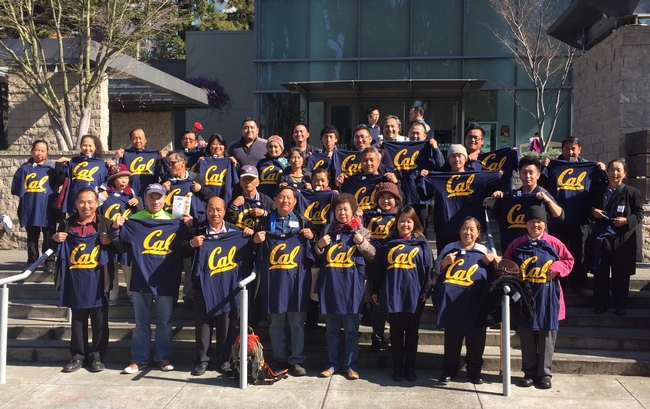
The University of California Global Food Initiative aims to put the world on a path to sustainably and nutritiously feed itself. By building on existing efforts and creating new collaborations among UC's 10 campuses, affiliated national laboratories and the Division of Agriculture and Natural Resources, the initiative will develop and export solutions for food security, health and sustainability throughout California, the United States and the world.

